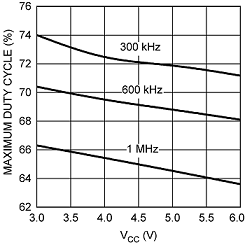JAJSA67I April 2004 – February 2019 LM2743
PRODUCTION DATA.
- 1 特長
- 2 アプリケーション
- 3 概要
- 4 改訂履歴
- 5 概要(続き)
- 6 Pin Configuration and Functions
- 7 Specifications
- 8 Detailed Description
- 9 Application and Implementation
- 10Power Supply Recommendations
- 11Layout
- 12デバイスおよびドキュメントのサポート
- 13メカニカル、パッケージ、および注文情報
9.2.1.2.2 Duty Cycle Calculation
The complete duty cycle for a buck converter is defined with Equation 16:

where VSWL and VSWH are the respective forward voltage drops that develop across the low side and high side MOSFETs. Assuming the inductor ripple current is 20% to 30% of the output current, therefore:
To calculate the maximum duty cycle use the estimated 'hot' RDS(on) value of the MOSFETs, the minimum input voltage, and maximum load. As shown in Figure 31, the worst case maximum duty cycles of the LM2743 occurs at 125°C junction temperature vs VCC (IC control section voltage). Ensure that the operating duty cycle is below the curve in Figure 31, if this condition is not satisfied, the system will be unable to develop the required duty cycle to derive the necessary system power and so the output voltage will fall out of regulation.
 Figure 31. Maximum Duty Cycle vs VCC
Figure 31. Maximum Duty Cycle vs VCC
TJ = 125°C